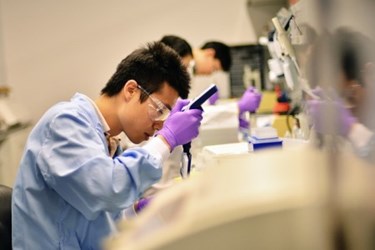Study: U.S. Clinical Research Dropped 32 Percent In 2014
By Jof Enriquez,
Follow me on Twitter @jofenriq

Drug and device industry spending on clinical research in the United States dropped 32 percent in 2014 compared to 2013, according to a new report.
Per Life Science Compliance Update, an analysis of the Centers for Medicare and Medicaid Services (CMS) Open Payments database reveals that drug and device manufacturers spent about $1.5 billion in research payments between August 2013 and December 2013. However, for the same five-month period in 2014, research payments for physicians, academic institutions, and third-party research organizations dropped $500 million to about $1 billion.
Clinical research spending was down regardless of recipient type and geographic location, as well as across medical specialties. From 2013 to 2014, research spending for hematology/oncology decreased by more than 50 percent to $121 million; medical oncology dropped by 34 percent to $37 million; and psychiatry declined by 48 percent to $37 million, according to a news release. All states reported lower research payments, including some that suffered huge drops.
"Although this is only a partial year comparison, it suggests a disturbing trend that we will want to watch closely moving forward," said Thomas Sullivan, editor of Life Science Compliance Update, in the release. "A decline in domestic research would be an unfortunate unintended consequence of transparency."
The Sunshine Act, a part of the Patient Protection and Affordable Care Act of 2010 (that went into effect in 2013), requires device, pharmaceutical, biologics, and medical supply manufacturers to collect and report to CMS information concerning payments to physicians and teaching hospitals, in addition to physician ownership or investment interests. CMS publishes this data in the Open Payments website for public access.
"It's a bit early to identify precisely what's driving this trend, but one explanation is that companies are moving their research contracts overseas," Sullivan added in the statement. "It's also equally plausible that as healthcare professionals are increasingly employed by hospitals, they have less autonomy and potentially less time to work on various research endeavors. We also suggest that the added scrutiny of Open Payments reporting is a disincentive to such collaboration."
According to an article in The Verge, data from the Journal of the American Medical Association (JAMA) revealed that medical research funding in the U.S. decreased by 0.8 percent annually from 2004 through 2012. The U.S. contribution to global investment in medical research dropped from 57 percent in 2004, to 44 percent in 2012. Asian countries increased research spending by 7 percent during the same period. Moreover, U.S.-held valuable life science patents also dropped from 73 percent in 1981 to 59 percent in 2011.
"The United States is at risk of losing its global scientific leadership and competitiveness," stated Victor Dzau and Harvey Fineberg, current and past presidents, respectively, of the Institute of Medicine of the National Academies in Washington, D.C., in an editorial published with the JAMA study. "One indicator after another demonstrates numerous other countries outpacing the United States in their commitment to research."
Pending legislation, particularly the 21st Century Cures bill, is designed to help the U.S. maintain its edge in biomedical research by allocating $8.75 billion in research funding to the National Institutes of Health (NIH) in the next five years, and streamlining FDA processes to foster drug and medtech innovation.
